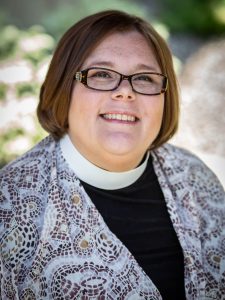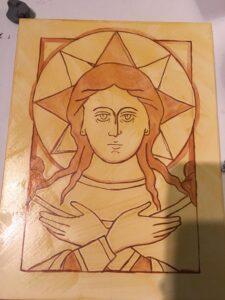 By Pastor Norma Malfatti
By Pastor Norma Malfatti
Pastor Norma painting an icon
Each Lent I spend time with a new icon. Growing up, icons weren’t things we talked about in my church. They were images that my Roman Catholic friends, not my Protestant ones, had in their homes. So I assumed that meant it wasn’t something “we” did.
Several years ago I went to Turkey and Greece to follow in the footsteps of Paul, learning more about his ministry and the people he shared the Gospel with. During my time in Greece, my curiosity and imagination for iconography was also piqued as I saw icons everywhere. It was easy to see that iconography plays a significant role in the life of people who are Greek Orthodox, from the ornate icons with gold plating in church buildings to simpler ones made with gold leaf or paint in people’s homes; icons are everywhere.
“Of all the varied faith practices I have tried to follow, painting icons and using them in my prayer life is the one I return to again and again.”
I asked our tour guide to tell me more because I wanted to understand her faith better. This is what I learned:
First and foremost, Greek Orthodox Christians who use iconography in their prayer life do not worship those icons or the people depicted in them; they worship God and God alone. However, they pay their respects to their forefathers and foremothers in faith through the icons.
Greek Orthodox spirituality has a very deep and intimate connection with the communion of saints and the ways the Holy Spirit connects us all across time and space, something we remind ourselves of on All Saints’ Day. So when they ask a saint to pray for them, it is like asking the person in the pew next to you to pray for you when you’re in need of prayer. Icons serve as a constant reminder of God’s presence in their lives and they draw strength from the saints depicted in the icons as they remember their witness to God’s love.
I PURCHASED MY first icon on that trip: Simeon and Anna with the infant Jesus. Simeon’s bold proclamation in Luke 2 that his own eyes had seen the salvation of God and he was prepared to die, as well as Anna’s prophetic words about Jesus’ life and Mary’s coming heartbreak, had been a favorite passage of my mother’s and I wanted us to have that icon in our home.

Norma’s Holy Innocense icon in process
Not long after I returned from that trip, I was invited to participate in an iconography class with the opportunity to create my very own icon. At first I was resistant. I have very little artistic skill, but the friend who invited me knew of my interest in icons and promised that I didn’t need to be an artist to create one.
“What I discovered in the slow, methodical, patience-testing process of creating an icon is the very presence of God.”
I discovered in the slow, methodical, patience-testing process of creating an icon the very presence of God. Just as I used the icons in my home to rest in the presence of God and wonder about the life and witness of the saints depicted in them, as I paint each layer of color or highlighting, I wonder about the many layers of the people I paint. Whether the face of Jesus, Elijah receiving bread from a raven, or the complicated image of the Holy Trinity, I am drawn into the multi-faceted theological claims and spirituality in lives of the people I am creating and are being created in me.
An icon class showing of the products
Of all the varied faith practices I have tried to follow, painting icons and using them in my prayer life is the one I return to again and again. The Visio Divina (a visual version of Lectio Divina) practice of looking at the image and wondering, “what do I see and hear?,” has been profound even in its simplicity.
Perhaps this Lent, you might want to explore using an icon in your faith practice. If you’re curious, you can follow these steps that I use:
- Get ready: Sit comfortably and still the body. Focus on breathing.
- Look: Take time to look closely at the icon. What do you see? See ‘the more.” Take time.
- Look and reflect: What is the icon calling you to be? What is the message for you? What do you hear?
- Look and respond: Read the icon once more by gazing on it. Respond in prayer. Write/draw thoughts and prayers if you journal.
- Look and rest: Let the image of the icon rest in your heart.
- Be: Give time for this to happen!
